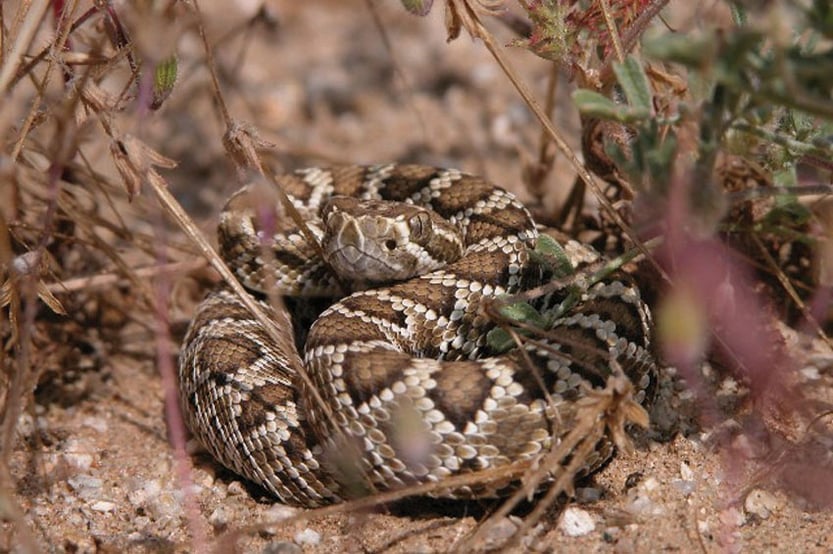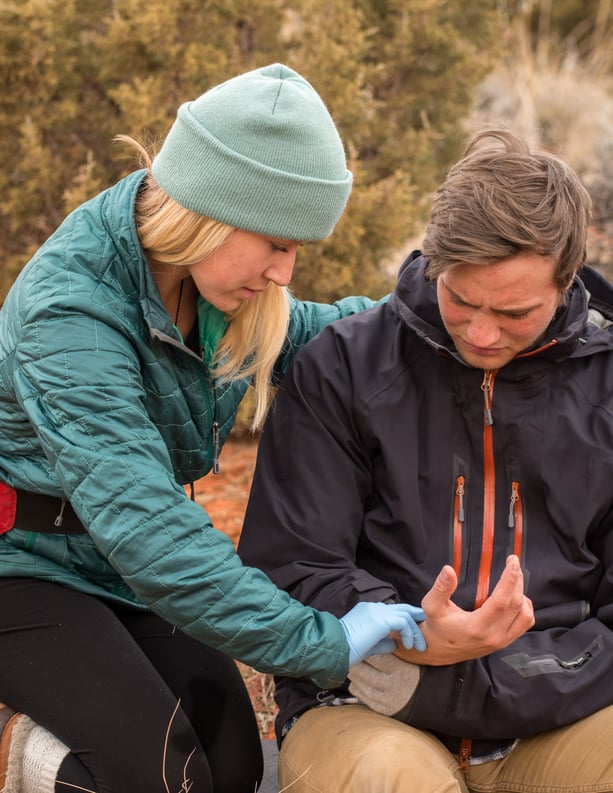The Setting
Editor’s Note: This case study was updated in 2024 to include more information about snakebites.
You are sampling some of the north facing overhanging limestone outside the famed Sinks Canyon climbing area in Wyoming. While walking along the base of the cliff, your partner drops a piece of gear and when they reach to retrieve it you hear a buzzing noise, a cry of surprise, then your partner falls backward.

Photo by Mark Bratton.
A snake with a triangular head and diamond pattern quickly slides around the corner. Your partner is sitting on the ground where they came to a stop. You rush down to them and, as you approach, they say, “It bit me!”
SOAP Report
Subjective
The patient is a 25-year-old female whose chief complaint is a possible snake bite to the right forearm. There is no mechanism for spine injury. The patient is A&O x 4.
Objective
Patient Exam
Patient is sitting and supporting their right forearm. Head-to-toe exam revealed two puncture wounds approximately 3/4” apart on the right forearm. One puncture is weeping clear fluid tinged with blood. Patient complains of persistent ache in right elbow, and states this was present prior to this event. There is no bruising or swelling at the bite site, no tingling or numbness in the arm, and good CSM in the right hand. Patient denies head, neck, and back pain, and did not lose responsiveness. No other injuries were found. CSMs are also normal in the feet and left hand.
Vital Signs
|
Time |
3:40pm |
4:00pm |
|
Level of Responsiveness (LOR) |
A&Ox4, anxious |
A&Ox4, anxious |
|
Heart Rate (HR) |
100, strong and regular |
80, strong and regular |
|
Respiratory Rate (RR) |
22, shallow and regular |
16, shallow and regular |
|
Skin Color, Temperature, Moisture (SCTM) |
pale, cool, clammy |
pink, warm, dry |
|
Blood Pressure (BP) |
strong radial pulse |
strong radial pulse |
|
Pupils |
PERRL (equal, round, responsive to light) |
PERRL |
|
Temperature (T°) |
not taken |
not taken |
History
|
Symptoms: |
Nausea, anxiety |
|
Allergies: |
Penicillin (not taken today). Seasonal allergies, not presently a problem. |
|
Medications: |
Ibuprofen 400mg for elbow pain, taken w/ breakfast, last 2 days. |
|
Pertinent Hx: |
Ache in right elbow for last two weeks. Believed to be climbing overuse injury. |
|
Last in/out: |
Energy bar at 1:00 p.m., 2 liters of water today, bowel movement normal, urine pale yellow |
|
Events: |
None relevant |
Pause here
What is your assessment and plan? Take a few minutes to figure out your own assessment and make a plan. Don’t cheat—no reading on without answering this first!
 Practicing giving patient care. Photo by Jared Steinman
Practicing giving patient care. Photo by Jared Steinman
Assessment
Patient has a probable snakebite on right forearm.
Plan
- Calm the patient.
- Clean the wound.
- Splint and immobilize right arm at the level of the heart.
- Monitor for signs of envenomation.
- Evacuate.
Anticipated problems
- If the patient was envenomated there may be increased pain, bruising and swelling, CSM deficit, or other signs of poisoning by the venom.
Comments
North American native snake envenomations are generally caused by Crotalids (pit vipers: rattlesnakes, water moccasins, copperheads) and far less frequently Elapids (coral snakes).
Signs and Symptoms
Crotalids
- Fang marks.
- Swelling and pain. If absent after 30 minutes, envenomation probably did not occur.
- Bruising and blister formation (over 6-36 hours) and later necrosis.
- Weakness, sweating and chills.
- Nausea and perhaps vomiting.
- Numbness and swollen lymph nodes.
Elapids
- Local swelling.
- Nausea, vomiting.
- Dizziness, weakness, respiratory difficulty (up to 12 hours after bite).
Treatment Principles for Snakebite
These apply worldwide:
- Scene safety: Don't create another victim by attempting to identify, capture or kill a snake.
- Calm yourself and the victim: envenomation is not a given in a snakebite.
- Immobilize the limb: avoid compression/constriction of the extremity.
- Transport to a physician/hospital: the treatment of envenomation is antivenom and supportive care.
- Document the s/s of envenomation to describe the progression to the physician.
- Avoid unproven or discredited treatments that may harm the patient: tourniquets, ice, electricity, meat tenderizer, incision and suction.
These vary by region:
- Wash the wound: Recommended in North America to prevent local wound infection. In Australia, it is not done as it prevents the surface assay to determine the species of snake. In India, it is not recommended because of concern the massage enhances venom distribution.
- Consider pain medications: avoid aspirin due to anticoagulation concerns.
- A wide elastic bandage (pressure immobilization bandage) wrapped distal to proximal as tight as an ankle wrap is recommended for North American coral snake bites and Australian Elapids. In India it is not recommended.
There is misinformation and lore surrounding snakebite first aid. Having the right information about this kind of injury will go far in keeping the patient from further harm.
Many people mistakenly believe a North American pit viper bite is often lethal. In fact, of the 7000-8000 bites reported yearly in the U.S., only 5 or 6 result in death. Death tends to occur in children, the elderly, and those who have delay in antivenom treatment.
Data suggests that envenomation from the pit viper is not automatic every time a snake strikes. Although exact numbers are hard to find, an estimated 30%-50% of reported snake bites are “dry” bites and do not result in envenomation.
Signs and symptoms of envenomation may not present early. Some snakes, such as the coral snake, are known to make you sick 12 or more hours after the bite. Waiting for s/s of envenomation may delay access to antivenom, thus we recommend that all snake bite patients be evacuated, and those with s/s of envenomation be rapidly evacuated.
The Tale Continues
You rinse off the wound and cover it with gauze then place the arm in a sling and swathe and walk five minutes back on the trail to the two-track road. From there you plan to bring your truck to the patient and head towards town.
On the way to the vehicle, you meet a young man with several medical and rescue patches who offers to pull the venom out by applying mechanical suction through a commercially made unit. Citing a recently published peer reviewed article describing the lack of effectiveness of this technique, you politely decline this offer of help and continue on your way. Nor do you accept his offer to cut your patient and draw the venom from the wound with suction applied orally. While you remember John Wayne doing this effectively to Kim Darby in the original movie True Grit (or Jeff Bridges and Hailee Seinfeld in the remake), you know it was only a movie. When you reach your vehicle you find a well-intentioned bystander who offers jumper cables and a car battery to render the venom impotent. This final obstacle between you and your patient’s best interest is calmly avoided.
Comment
When envenomation does occur there are a number of techniques erroneously believed to be effective. Don't perform any unproven or discredited treatments that may cause harm. Some bad treatments keep the venom in the extremity (tourniquet, ice), some try to deactivate the venom (ice, electricity, meat tenderizer, etc) and others try to remove the venom (incision and suction, suction). These techniques have been shown to lack effectiveness when studied in a clinical setting.
What we know to be effective is calming the patient, immobilizing the limb at the level of the heart and, once definitive care is reached, administering antivenom therapy as necessary.
End of the Tale
On the way to the hospital there is a noticeable increase in swelling. Your patient also reports an increase in pain locally, but their vital signs remain stable. By the time the hospital is reached your patient has a tingling sensation throughout the arm and there is bruise-like discoloration surrounding the punctures. The emergency room staff evaluate the patient and give antivenom treatment.
Learn more about treating snakebites on a wilderness medicine course.
Written By
Tod Schimelpfenig
As a NOLS Instructor since 1973 and a WEMT, volunteer EMT on ambulance and search and rescue squads since the 70s, Tod Schimelpfenig has extensive experience with wilderness risk management. He has used this valuable experience to conduct safety reviews as well as serve as the NOLS Risk Management Director for eight years, the NOLS Rocky Mountain Director for six years, and three years on the board of directors of the Wilderness Medical Society, where he received the WMS Warren Bowman Award for lifetime contribution to the field of wilderness medicine. Tod is the founder of the Wilderness Risk Manager’s Committee, has spoken at numerous conferences on pre-hospital and wilderness medicine, including the Australian National Conference on Risk Management in Outdoor Recreation, and has taught wilderness medicine around the world. He has written numerous articles on educational program, risk management and wilderness medicine topics, and currently reviews articles for the Journal of Wilderness and Environmental Medicine. Additionally, he is the author of NOLS Wilderness Medicine and co-author of Risk Management for Outdoor Leaders, as well as multiple articles regarding wilderness medicine. Tod is the retired curriculum director for NOLS Wilderness Medicine and is an active wilderness medicine instructor





